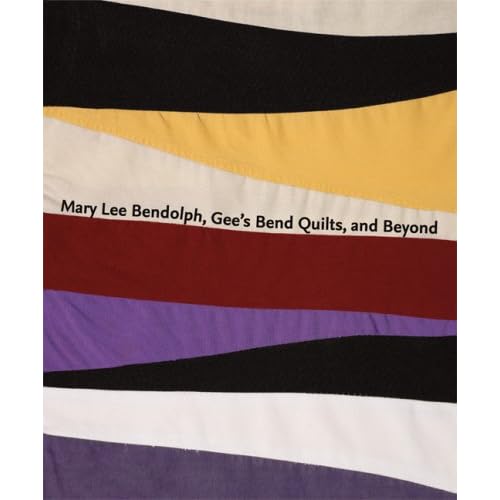 Annie Mae Young, Work-clothes quilt with center medallion of strips, 1976; denim, corduroy, synthetic blend; 108 by 76.5 inches.
Annie Mae Young, Work-clothes quilt with center medallion of strips, 1976; denim, corduroy, synthetic blend; 108 by 76.5 inches. The following videos offer a little window into the quilting community of Gee's Bend, Alabama:
 The women refer to their quilts in two ways, the "fancy" quilts, which they thought were good enough to sell and the quilts they made for everyday use. When they were first discovered by the fiber art world, those utilitarian quilts, worn, faded and often neglected were the ones collectors coveted. The fancy quilts use patterns recognizable in mainstream quilting traditions while the everyday ones spring from individual inspiration and availability of materials. Here are some examples shown on the official Gee's Bend website:
The women refer to their quilts in two ways, the "fancy" quilts, which they thought were good enough to sell and the quilts they made for everyday use. When they were first discovered by the fiber art world, those utilitarian quilts, worn, faded and often neglected were the ones collectors coveted. The fancy quilts use patterns recognizable in mainstream quilting traditions while the everyday ones spring from individual inspiration and availability of materials. Here are some examples shown on the official Gee's Bend website: Mary Lee Bendolph and Ruth P. Mosely Bricklayer
Mary Lee Bendolph and Ruth P. Mosely BricklayerFiberArts Magazine also had a nice article with these images:
This one was in the Austin Chronicle, but I couldn't find the info on it:
 The quilts show a whole range of color choices, designs, and skill levels, but all have an organic feel to them that suggests a "design as you go" approach. They contrast sharply with traditional quilts where hand quilting skills are judged by number of stitches per square inch or where perfection is the goal. As described in the first video, many of these Alabama quilters will make a whole quilt out of what would normally be one block in a traditional quilt. Zooming into color and texture, they disassemble the pattern as if looking through a magnifying lens.
The quilts show a whole range of color choices, designs, and skill levels, but all have an organic feel to them that suggests a "design as you go" approach. They contrast sharply with traditional quilts where hand quilting skills are judged by number of stitches per square inch or where perfection is the goal. As described in the first video, many of these Alabama quilters will make a whole quilt out of what would normally be one block in a traditional quilt. Zooming into color and texture, they disassemble the pattern as if looking through a magnifying lens.Most articles about Gee's Bend quilters make reference to parallels in the quilt designs to African textiles. Comparisons have also been made to abstract modern art. Do these women carry a subconscious memory of African patterns? Interviews with the women indicate that they do not have a large world view of what is available in the quilt world, but rather that the patterns simply appealed to their own inner sensibilities.
When I look at the quilts, I see some elements that can individually be found in many different traditions. As a group of textiles, they speak to a specific community bound by time and place which will not be replicated. Now that they have been "discovered", a certain loss of innocence is bound to happen, where function will be replaced by the desire to make saleable pieces or for recognition in the media. I don't know how this transformation will evolve over time, but change has been documented over and over again with individuals or communities who began humbly and then achieved international recognition. Will the women continue to allow spontaneity to dictate design? We cannot predict what will happen, but the African connection will surely present itself in a new way to these women who may carry those embedded patterns in their genes. Certainly, as they see others make the connections, they will also study themselves and their roots and perhaps make the connection even more pronounced. Most craft communities seem to end up with most of their members engaged in producing products for income generation. Then, a few of these blossom into something new, breaking boundaries and growing into the mentors, visionaries, and muses who will inspire the next generation.
We shall watch Gee's Bend and see how it evolves over the years. My gut tells me that we will continue to see objects of wonder grow out of this community, even as they evolve from the "naive" to the "expert".
Books on Gee's Bend available on Amazon:
(Click on the link below the image)









Thanks for this post - I really like looking at these quilts. I am not a traditional quilter so I find them very inspiring.
ReplyDeleteAnd I'm sure you know that there is controversy in the quilt world about the influence of African textiles on some African-American quilters in the southern US. There were some articles published stating that this influence was a fact but many quilters and quilt historians now think that this particular style is not related to ethnicity. I have seen quilts similar to this made by non-African-American women in West Virginia - the common idea seems to be to create utility quilts that are also attractive.
Thanks again!
I love these quilts. I saw them at The Whitney in NYC several years ago, and I splurged on the books, too. I LOVE looking at those books.
ReplyDelete